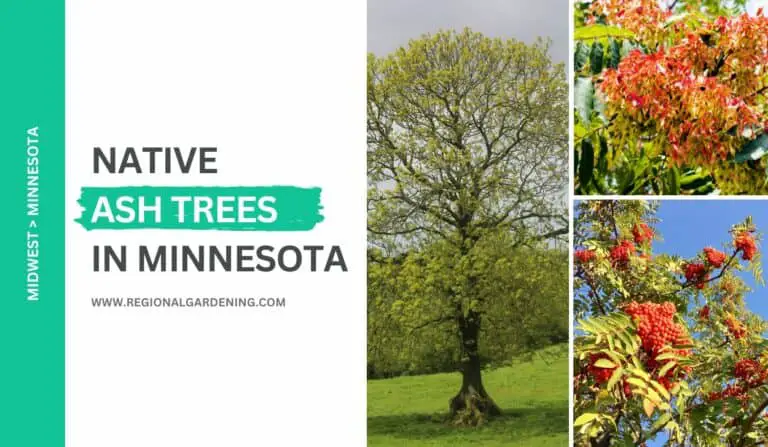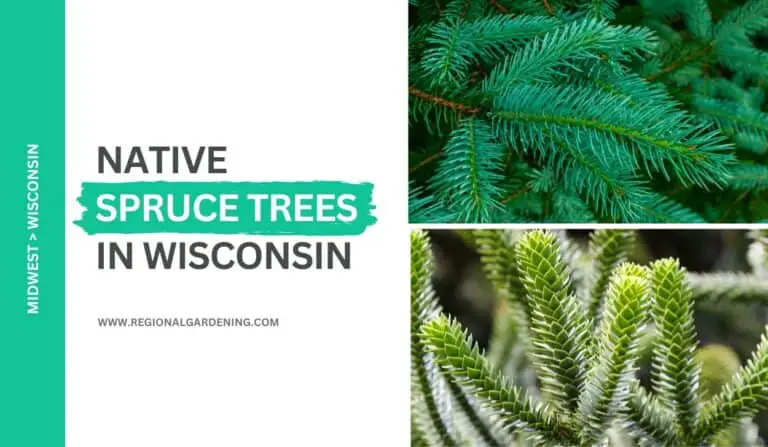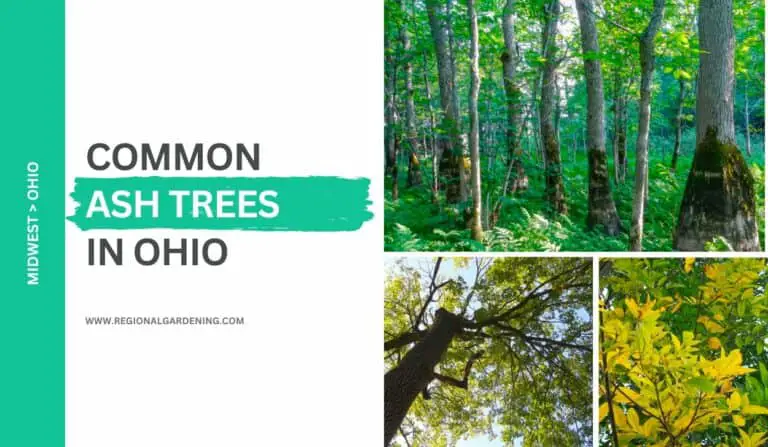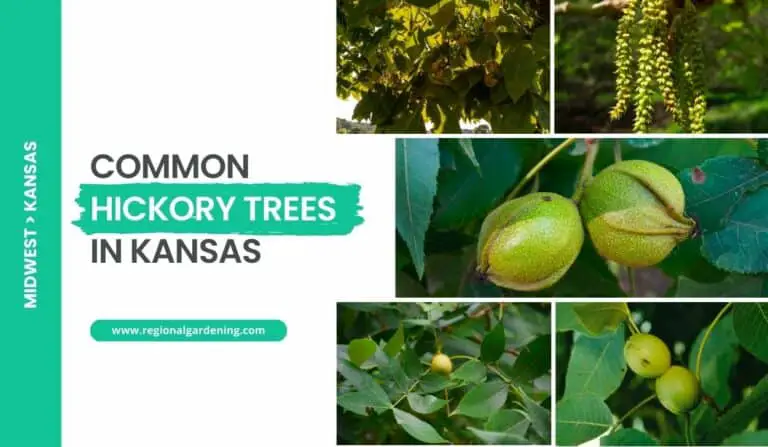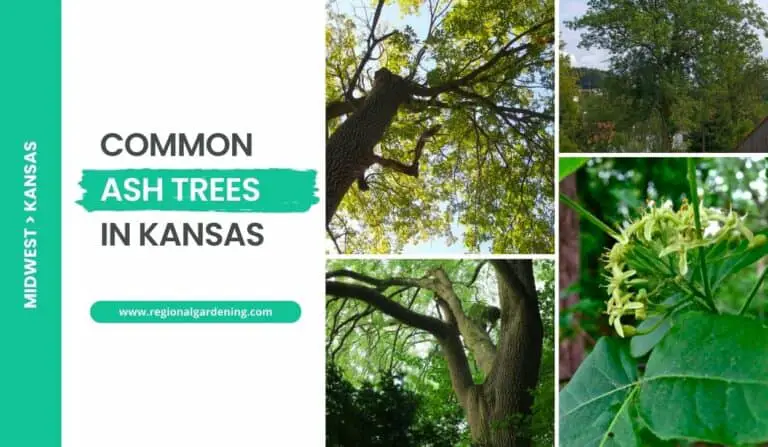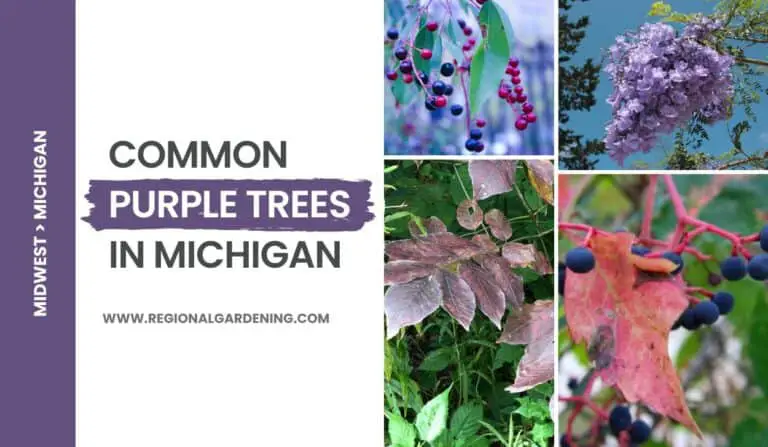11 Native Oak Trees In Kansas (Photos & Identification)
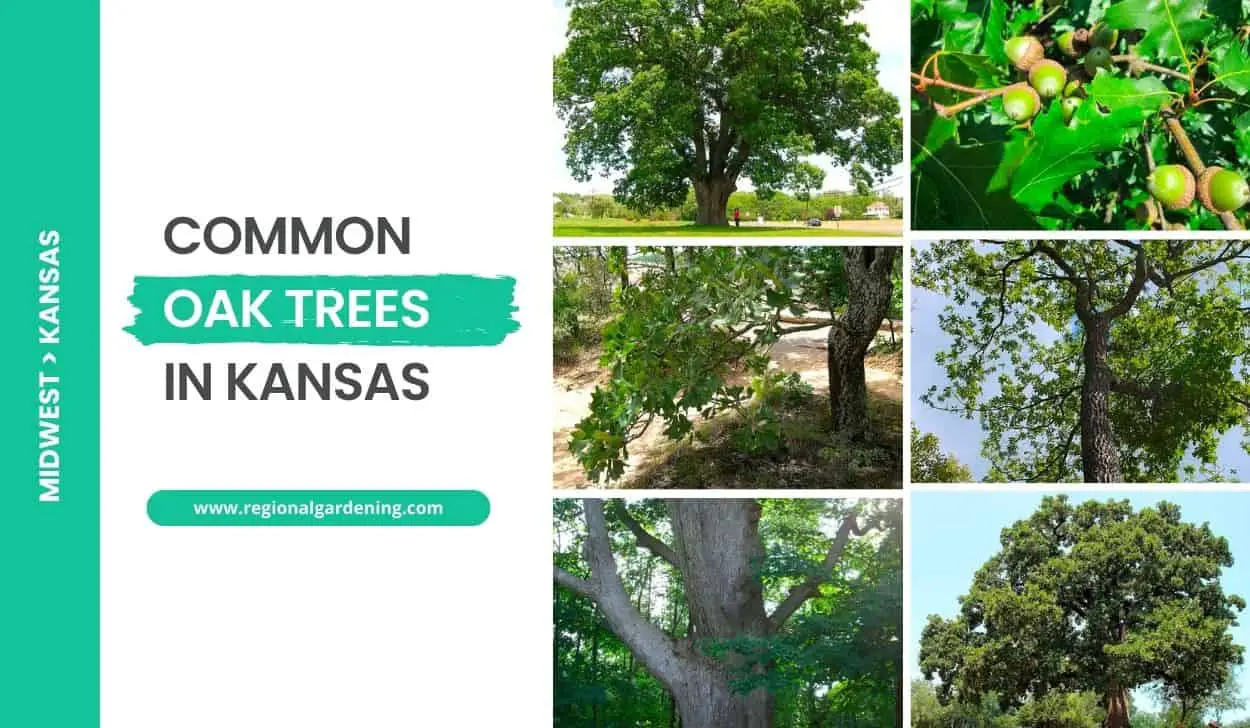
Oaks are known for their long lifespan, strong structure, and majestic appearance. Understanding the various types of native oak trees in Kansas allows us to appreciate their incredible diversity in terms of leaf shape, bark texture, and overall growth habits.
To help you with your research, we will look at 11 common native oak trees in Kansas and provide you with stunning photos and an in-depth identification guide.
So, let’s get started.
1. Black Oak
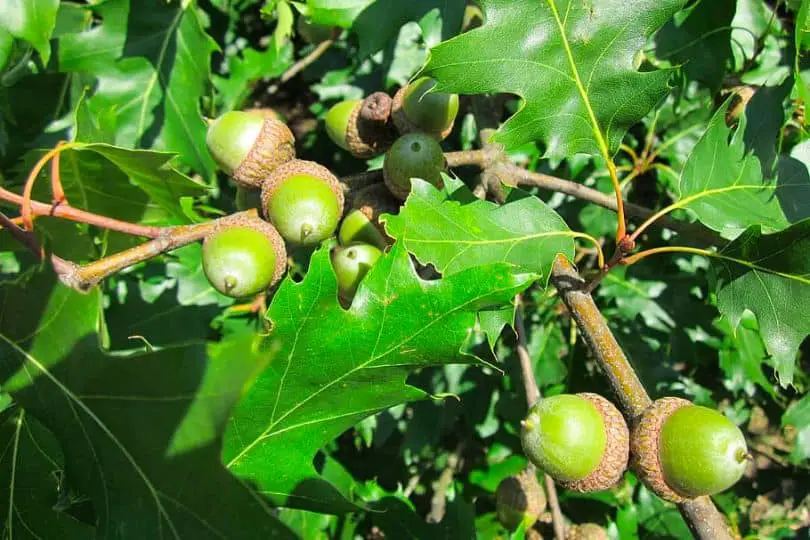
- Scientific Name: Quercus velutina
- Common Name(s): Black Oak
- Mature Height: 50-80 feet (15-24 meters)
- Native Region: North America
- Flowers: No Flowers
- Fruit: Acorns
- Uses: Lumber, fuelwood, wildlife habitat
The black oak, scientifically known as Quercus velutina, is a North American deciduous tree. Because of its adaptability and versatility, it is widely found in Kansas settings. The black oak is a tall tree that can grow to be 50-80 feet (15-24 meters) tall when mature, making it an ideal shade tree for broad areas.
The black oak has huge, broad leaves that are dark green and have a distinctive lobed form. These leaves become a vivid crimson or orange in the fall, giving a magnificent display of autumn hues. The bark of the black oak is dark gray and wrinkled, which adds to its overall beauty.
In terms of habitat, the black oak prefers upland forests and woodlands. It may grow in a variety of soil types, but favors well-drained soils. This tree is also noted for its tenacity and capacity to tolerate drought conditions, making it an excellent choice for the Kansas environment.
While the black oak does not bloom, it does yield fruit in the form of acorns. Acorns are a significant source of food for a variety of wildlife species, including birds, squirrels, and deer. Furthermore, black oak wood is highly recognized for its strength and durability, making it a popular choice for timber. It is extensively used in building, furniture manufacturing, and flooring.
It is critical to give appropriate spacing when planting black oak trees in Kansas landscape to allow its mature height. This tree prefers full sun but may tolerate partial shade. Watering is required on a regular basis during the establishment stage, but once established, the black oak is generally low-maintenance. Pruning may be required to keep its shape and to remove any dead or damaged branches.
2. White Oak
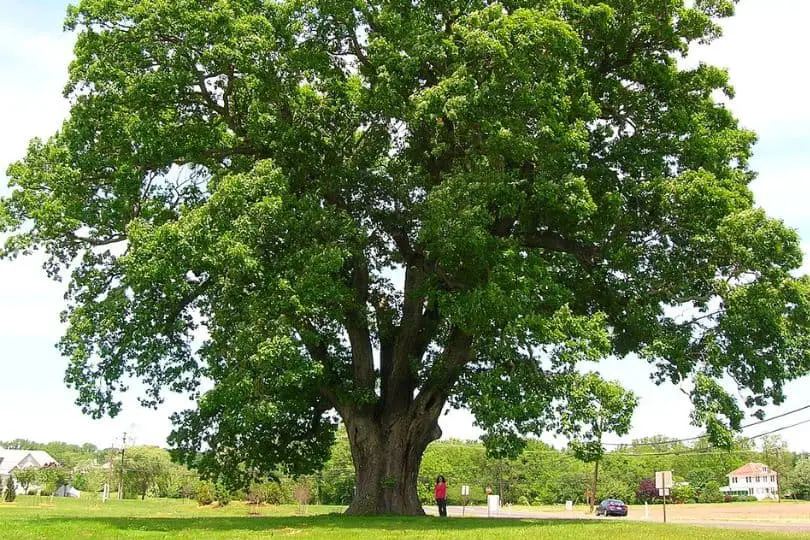
- Scientific Name: Quercus alba
- Common Name(s): White Oak
- Mature Height: 60-100 feet (18-30 meters)
- Native Region: North America
- Flowers: White, small, not very noticeable.
- Fruit: Acorns, which mature in 1 year and are an important food source for wildlife.
- Uses: White oak is often used for furniture, cabinetry, flooring, barrels, and veneer. It is also valued as a shade tree and for its wildlife habitat.
White oak (Quercus alba) is a North American deciduous tree. It is a huge tree that can grow to be 60-100 feet tall and spread up to 50 feet wide. The crown is broad and rounded, and it provides plenty of shade. White oak leaves are lobed, with 7-9 rounded lobes per leaf. The lobes are deep and almost reach the midrib, creating a characteristic silhouette for the leaf. Before dropping, the leaves turn a gorgeous reddish-brown color in the autumn.
White oak has light gray to light brown bark that turns scaly as it ages. The bark is hard and flat, giving the tree a rustic appearance. In late April, the tree produces small, inconspicuous flowers. The acorns, on the other hand, are the tree’s most noticeable feature. The acorns are roughly one inch long and light brown in hue. They grow in one year and are a vital food source for wildlife.
White oak can be cultivated in Kansas as an outdoor tree in landscapes as well as an indoor tree in large containers. It prefers full sun to light shade and wet, well-drained soil. Watering is essential during dry periods, especially for young trees. To maintain desired form and remove any dead or damaged branches, pruning should be done during the dormant season.
White oak is prized for its wood, which is sturdy, long-lasting, and resistant to rot. It is extensively used in the manufacture of furniture, cabinetry, flooring, barrels, and veneer. The shade provided by the tree is also highly prized, and it is commonly planted as a street or park tree. It is a significant tree for the ecosystem since it supplies habitat and food for a variety of wildlife species.
3. Blackjack Oak
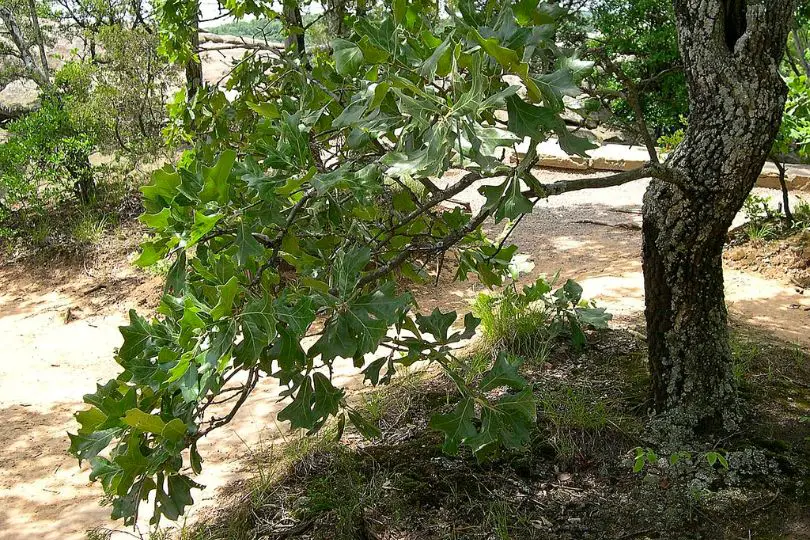
- Scientific Name: Quercus marilandica
- Common Name(s): Blackjack Oak, Barren Oak, Quercitron
- Mature Height: 20-50 feet (6-15 meters)
- Native Region: Eastern and central North America
- Flowers: No Flowers
- Fruit: Acorns
- Uses: Wildlife habitat, erosion control, firewood, and timber
The Blackjack Oak, formally known as Quercus marilandica, is a beech-like medium-sized deciduous tree. It is common in Kansas landscapes as well as eastern and central North America. The tree matures to a height of 20-50 feet (6-15 meters) and has a characteristic rough aspect.
The Blackjack Oak’s leaves are alternately oriented, simple, and have a distinct shape with 3-5 strongly lobed pointy points like a blackjack or club. In the fall, the leaves turn a gorgeous crimson color before dropping. The bark on mature trees is dark and severely wrinkled, which adds to their rough and rugged appearance.
This native tree is well suited to hard environments and is well renowned for its drought and poor soil tolerance. It is frequently seen growing on dry, rocky hillsides, as well as sandy or clay soils. It is a good choice for Kansas landscapes since it can tolerate the region’s hot and dry summers.
The Blackjack Oak produces little, spherical acorns rather than beautiful blooms. These acorns provide food for a variety of wildlife species, including birds, deer, squirrels, and turkeys. The tree itself provides important habitat for a variety of species.
Once established, the Blackjack Oak requires little attention in terms of care. It enjoys full sun and well-drained soil, but will grow in a variety of soil conditions. This tree has a deep taproot that aids in its resistance to drought and root competition. Watering on a regular basis over the first year can help it establish.
The Blackjack Oak has a wide range of applications. Because of its powerful root system, it is widely planted for erosion control. It can also be used as firewood or for small-scale timber production. Although it is not as commercially valuable as other oak species, its dense, strong timber makes it appropriate for furniture, barrels, and even flooring.
4. Chestnut Oak
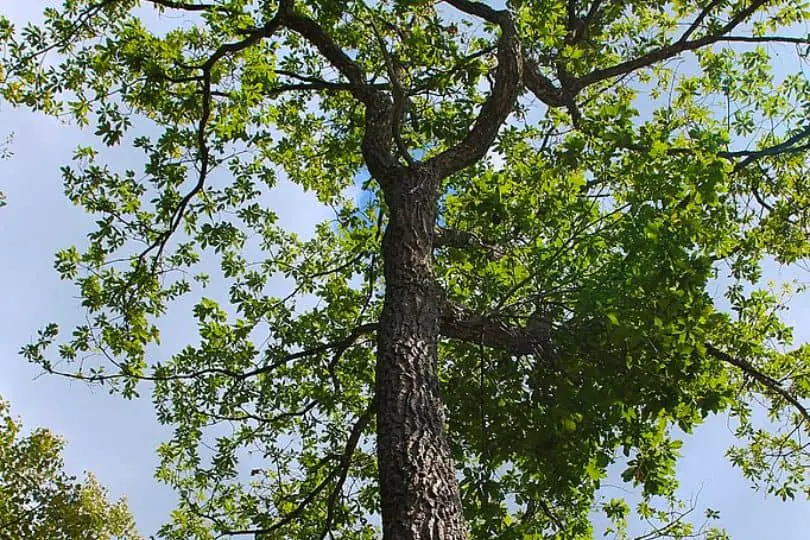
- Scientific Name: Quercus montana
- Common Name(s): Chestnut Oak, Rock Oak
- Mature Height: 50–80 feet (15–24 meters)
- Native Region: Eastern and Midwestern United States
- Flowers: No Flowers
- Fruit: Acorns
- Uses: Timber, wildlife habitat, shade tree
The Chestnut Oak (Quercus montana) is a medium to large-sized deciduous tree that is abundant in Kansas settings. It matures to a height of 50 to 80 feet, making it an ideal shade tree. The tree is indigenous to the eastern and midwestern United States, including Kansas.
The Chestnut Oak has distinct traits that allow it to be identified. The leaves are rectangular and range in length from 4 to 8 inches, with pronounced teeth along the borders. In the fall, these leaves develop a gorgeous yellow-brown color, creating stunning autumn beauty. The Chestnut Oak’s bark is dark gray with deep furrows, contributing to the tree’s overall appeal.
The Chestnut Oak prefers dry, well-drained soil and is most usually found in upland woodlands, slopes, and ridges. It is a sturdy tree that can resist harsh circumstances, making it an excellent choice for Kansas landscapes. It is adaptable to both indoor and outdoor environments, making it an excellent choice for gardens, parks, and residential yards.
The Chestnut Oak does not produce spectacular blossoms, but it does yield acorns as its fruit. Squirrels, deer, and birds eat these acorns, which are a vital food source for a variety of animals. Furthermore, the tree’s wide-spreading canopy provides excellent shade, making it ideal for picnics and outdoor events.
It is critical to provide ample sunlight and well-drained soil when caring for Chestnut Oak trees in Kansas. Regular watering is required during the early stages of growth, although the tree is drought-tolerant once established. Pruning may be necessary on occasion to keep a desirable shape and eliminate dead or unhealthy branches.
The Chestnut Oak trees in Kansas landscapes fulfills several functions. Its timber is highly prized for its strength and durability, making it ideal for furniture, flooring, and building. The tree also provides wildlife habitat and adds to the overall aesthetic appeal of the area. The Chestnut Oak is a good choice for bringing both beauty and functionality to Kansas landscapes due to its ability to grow in a variety of climates.
5. Chinkapin Oak
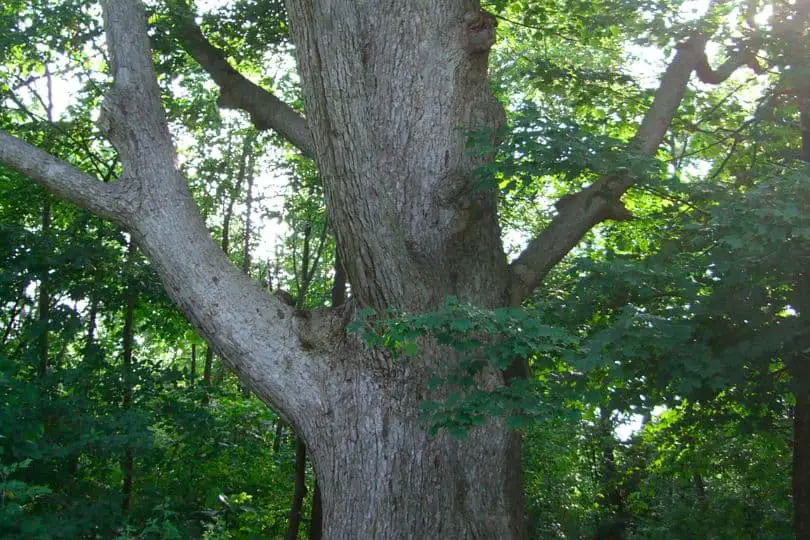
- Scientific Name: Quercus muehlenbergii
- Common Name(s): Chinkapin Oak, Chinquapin Oak
- Mature Height: 40-60 feet (12-18 meters)
- Native Region: North America
- Flowers: No Flowers
- Fruit: Small acorns with a thin cap
- Uses: Shade tree, lumber, wildlife habitat
The Chinkapin Oak, technically known as Quercus muehlenbergii, is a North American deciduous tree. It can grow to be 40-60 feet (12-18 meters) tall and 35-45 feet (10-14 meters) wide when mature. This tree’s appealing rounded shape and dense crown make it an excellent shade tree for large settings.
The Chinkapin Oak has simple, lobed leaves with bristly tips that turn yellowish-brown in the fall. The tree’s bark is grayish-brown and develops shallow fractures with age. Many wildlife species rely on the small, spherical acorns with a thin top produced by this oak tree.
The Chinkapin Oak is typically found in upland woodlands and well-drained soils in its native location. It grows well in full sun to partial shade in Kansas landscapes and tolerates a wide range of soil types, including clay and loamy soils. Once established, it is well-known for its drought resistance.
This oak tree is low-maintenance and does not require extensive trimming. However, it is advised that dead or broken branches be removed for aesthetic reasons. Regular watering is required throughout the establishing period, but once established, it can thrive solely on natural rains.
The Chinkapin Oak provides excellent wildlife habitat and food, attracting a variety of bird species, squirrels, and deer. Its hardwood is also utilized for lumber, furniture, and flooring. The Chinkapin Oak is a good choice for Kansas landscapes due to its appealing appearance, drought tolerance, and wildlife advantages.
6. Pin Oak
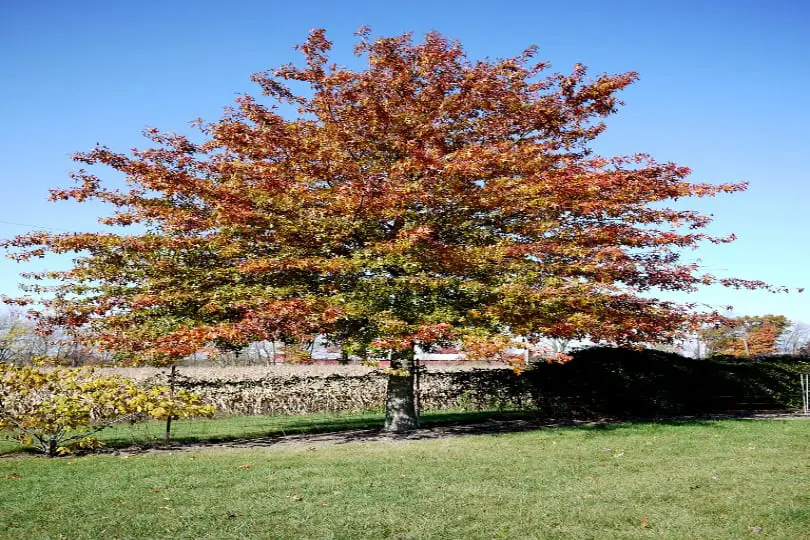
- Scientific Name: Quercus palustris
- Common Name(s): Pin Oak
- Mature Height: 60-70 feet (18-21 meters)
- Native Region: Eastern United States
- Flowers: No flowers.
- Fruit: Small acorns.
- Uses: Pin Oak is commonly used as a shade tree and as an ornamental tree in landscapes. The wood of Pin Oak is not commonly used due to its tendency to crack and split, but it can be used for firewood.
Pin Oak (Quercus palustris) is a deciduous oak tree native to the eastern United States. It is well-known for its unusual pyramidal shape and capacity to withstand damp soil conditions. The Pin Oak matures to a height of 60-70 feet and a spread of 40-50 feet.
The Pin Oak’s leaves are deeply lobed and lustrous green in the summer, turning russet-red or brown in the fall. The tree’s bark is grayish-brown and develops vertical fissures as it ages.
The Pin Oak is native to eastern North America, including Kansas. It grows well on moist, well-drained soil and is commonly found in floodplains and wetland settings. It is a popular choice for planting in urban environments since it adapts to a wide range of soil types and can withstand mild drought.
While the Pin Oak does not have spectacular blossoms, it does have little acorns that provide food for wildlife. Typically, these acorns are not picked for human consumption. The Pin Oak needs to be watered on a regular basis, especially during droughts. It should be placed somewhere that gets full sun to partial shade. Pruning should be done in late winter or early spring to keep the contour of the tree.
The Pin Oak is a popular shade tree in Kansas settings, particularly in parks, residential yards, and along streets. It adds aesthetic appeal to the environment and delivers superb fall color with its russet-red foliage. Furthermore, the Pin Oak provides animal habitat and attracts birds with its acorns.
7. Post Oak
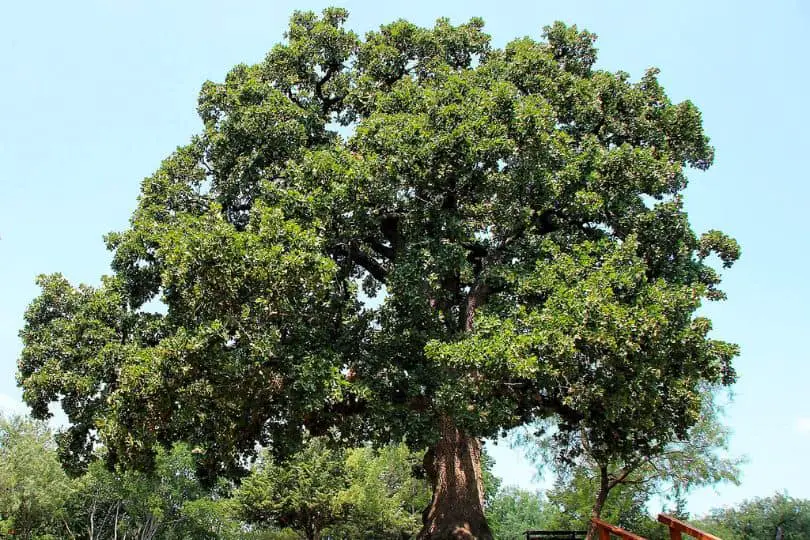
- Scientific Name: Quercus stellata
- Common Name(s): Post Oak
- Mature Height: 40-50 feet (12-15 meters)
- Native Region: North America
- Flowers: No Flowers
- Fruit: Small acorns
- Uses: Post oak trees in Kansas are commonly used as shade trees and for landscaping purposes. The wood of the tree is highly durable and is used for making fence posts, railroad ties, and furniture.
The Post Oak (Quercus stellata) is a type of oak tree that is widely seen in Kansas settings. It can grow to be 40-50 feet (12-15 meters) tall when mature. The Post Oak is a native of North America with a large range that includes Kansas.
This oak has particular traits that make it easy to identify. Post Oak leaves are dark green in color, with shallow lobes and a bristle-tipped look. On older trees, the bark is grayish-brown and tough, forming deep furrows. The tree grows a circular crown that gives plenty of shade.
The Post Oak flourishes in a wide range of soil types, including clay, sand, and loam. It can withstand both dry and wet climates, giving it a versatile choice for Kansas settings. It’s most frequent in open forests, savannas, and grasslands.
The Post Oak does not have spectacular blossoms, but it does yield little acorns as a fruit. These acorns provide food for a variety of species, including squirrels, deer, and birds. The tree’s robust branches also attract a variety of bird species.
The Post Oak loves full sun exposure in a Kansas environment, but it may take little shade. Once planted, it is drought-tolerant and requires little watering. Pruning on a regular basis can help to preserve a healthy shape and remove any dead or damaged branches.
The Post Oak is widely utilized for landscaping in Kansas, providing shade in both residential and commercial locations. Its solid wood is extremely robust and decay-resistant, making it a favorite choice for fence posts, railroad ties, and furniture. The tree also provides significant habitat for wildlife, contributing to the region’s unique biodiversity.
8. Bur Oak
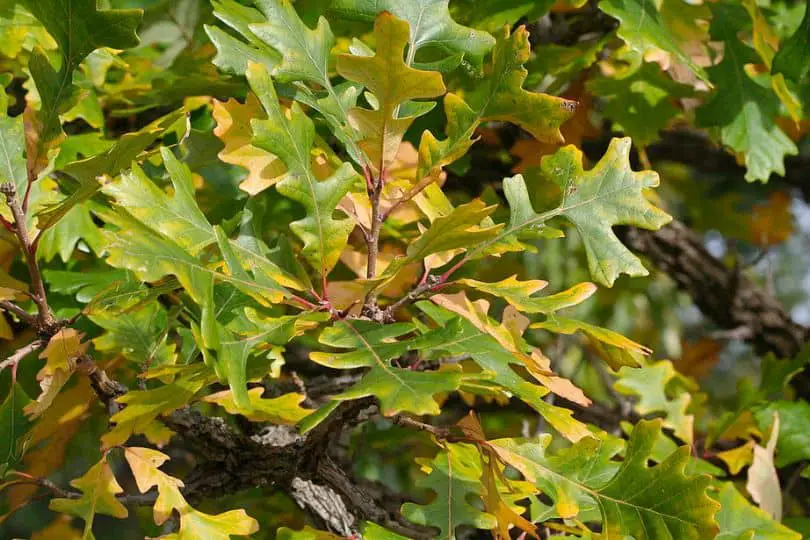
- Scientific Name: Quercus macrocarpa
- Common Name(s): Bur Oak, Mossycup Oak
- Mature Height: 70-100 feet (21-30 meters)
- Native Region: North America
- Flowers: Yellow-green catkins
- Fruit: Acorns with mossy caps
- Uses: Shade tree, ornamental tree, wildlife habitat, erosion control, wood for furniture and fence posts.
The Bur Oak (Quercus macrocarpa) is a huge, stately North American oak. It can grow to be 70-100 feet (21-30 meters) tall when mature, making it an ideal choice for providing shade in big settings. The Bur Oak is named by its rough and thick bark, which produces deep furrows as it ages.
The Bur Oak’s leaves are leathery and dark green. They are deeply lobed with rounded tips and can reach a length of 12 inches. Before falling, the leaves turn a gorgeous golden-yellow tint.
This oak tree is well-known for its massive acorns. The acorns are around 1-2 inches long and have a mossy crown, hence the common name “Mossycup Oak.” They are a vital food source for wildlife such as squirrels, deer, and birds.
Because of its gorgeous foliage and hardiness, the Bur Oak is often employed as a shade tree and ornamental tree in Kansas settings. It is highly versatile and can withstand a wide range of soil conditions. The Bur Oak is also drought and heat hardy, making it ideal for the Kansas climate.
Furthermore, these trees provide habitat for a variety of wildlife species, making them an important part of any landscape. They are frequently planted for erosion prevention because their vast root system aids in soil stabilization.
The Bur Oak requires little attention in terms of upkeep. It enjoys full light but may tolerate some shade. Watering on a regular basis is required during the first several years to build a healthy root system. The tree is drought-tolerant once planted and may survive with little watering.
Bur Oak wood is extremely durable and is widely used to make furniture, flooring, and fence posts. Acorns can also be gathered and used to produce new trees, or they can be roasted or mixed into flour and used as a food source for people.
9. Shumard Oak
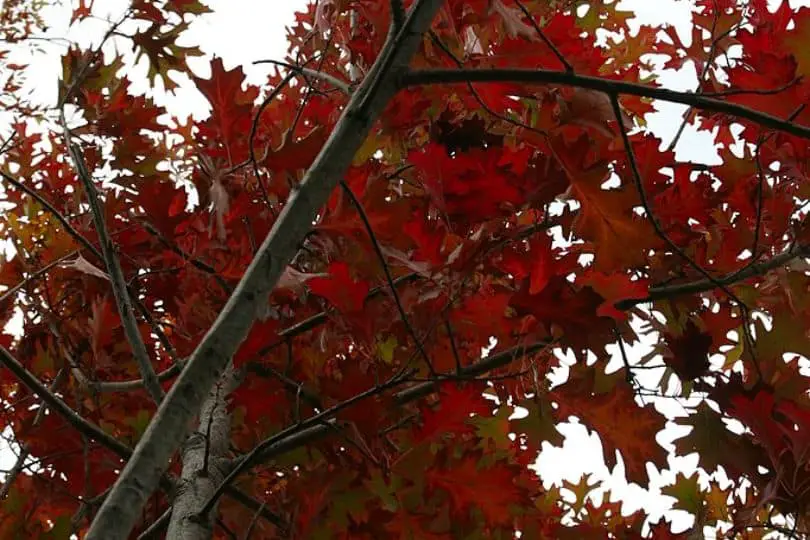
- Scientific Name: Quercus shumardii
- Common Name(s): Shumard Oak
- Mature Height: 60-80 feet (18-24 meters)
- Native Region: Central and eastern United States
- Flowers: No flowers
- Fruit: Acorns
- Uses: Shumard Oak is commonly used in landscaping and as a shade tree. The wood of this oak is also used for making furniture, barrels, and flooring.
Shumard Oak (Quercus shumardii) is a huge deciduous tree that can reach mature heights of 60-80 feet (18-24 meters). It is indigenous to the central and eastern United States, including Kansas. This oak tree has a rounded to oval crown and strong limbs that offer plenty of shade.
Shumard Oak leaves are alternating, simple, and lobed, with deep sinuses. During the summer, they are a beautiful dark green, and in the fall, they change brilliant hues of red, orange, and yellow. The bark is thick, with gray-brown ridges and furrows that add to the tree’s beauty.
Shumard Oak grows best on well-drained soils, such as clay, loam, and sandy soils. It can endure both moist and dry environments and is quite adaptive to different soil pH levels. As a result, it is an excellent choice for Kansas settings.
The blossoms of Shumard Oak are not particularly showy. Instead, it produces acorns, which are an essential source of food for wildlife. The acorns are around 1-1.5 inches long and have a shallow cup at the base.
If you intend to plant Shumard Oak trees in Kansas settings, keep in mind that it is a slow-growing tree. It prefers full sun to moderate shade and needs to be watered on a regular basis, especially during dry seasons. The tree requires little care, however it may benefit from occasional trimming to remove dead or crossed branches.
Shumard Oak has various purposes aside from its ornamental value as a shade tree. Its wood is sturdy and long-lasting, making it ideal for a variety of woodworking applications. It is widely utilized in the manufacture of furniture, flooring, cabinetry, and even barrels for the aging of wine and whiskey.
10. Northern Red Oak
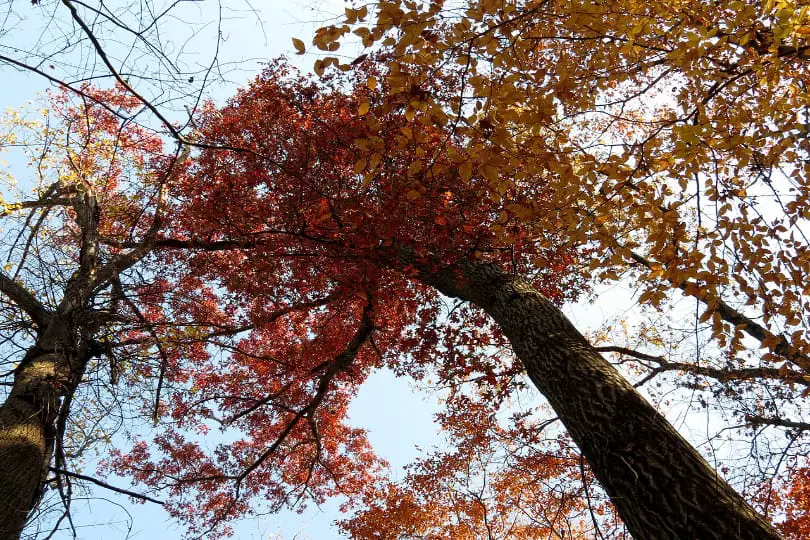
- Scientific Name: Quercus rubra
- Common Name(s): Northern Red Oak
- Mature Height: 60-75 feet (18-23 meters)
- Native Region: North America
- Flowers: No Flowers
- Fruits: Acorns
- Uses: The wood of the Northern Red Oak is commonly used for flooring, furniture, and cabinets. The acorns provide food for wildlife.
The Northern Red Oak, also known scientifically as Quercus rubra, is a huge deciduous oak endemic to North America. It matures at a height of 60-75 feet (18-23 meters) and a spread of 45-50 feet (14-15 meters). The tree’s broad, rounded crown and sturdy limbs that produce a dense canopy distinguish it. Because of its unique crimson fall leaves, the Northern crimson Oak is a popular choice for landscaping.
Northern Red Oak leaves are alternating and simple, with lobed margins. In the summer, they are six to nine inches long and a dark green tint. The leaves turn a brilliant red in the fall, earning the tree its common name. The tree’s bark is dark gray and develops deep furrows and ridges as it grows.
Northern Red Oak is native to a variety of environments, including moist bottomlands and dry highland forests. It is tolerant to a wide range of soil types and can withstand both acidic and alkaline conditions. Northern Red Oak thrives in well-drained soils and full sun exposure in Kansas landscapes. It is a fantastic choice for adding aesthetic flair and shade to residential yards and parks.
The Northern Red Oak does not have spectacular blossoms, but it does have acorns. The oval-shaped acorns are a major food source for wildlife such as squirrels, deer, and birds. The tree has a lengthy lifespan, with some trees living for more than 300 years.
It is critical to provide regular irrigation to Northern Red Oak trees in Kansas landscape, especially during dry years. Mulching around the base of the tree aids in moisture retention and weed control. Pruning may be required to keep the branch structure balanced and to eliminate dead or damaged branches. Regular pest and disease monitoring, such as for oak wilt, is also essential for the tree’s health.
Northern Red Oak is regarded for its robust and handsome wood, in addition to its aesthetic value. Flooring, furniture, cabinets, and other woodworking projects typically make use of the wood. The tree’s acorns are a vital food source for wildlife, adding to the ecological diversity of Kansas landscapes.
11. Shingle Oak
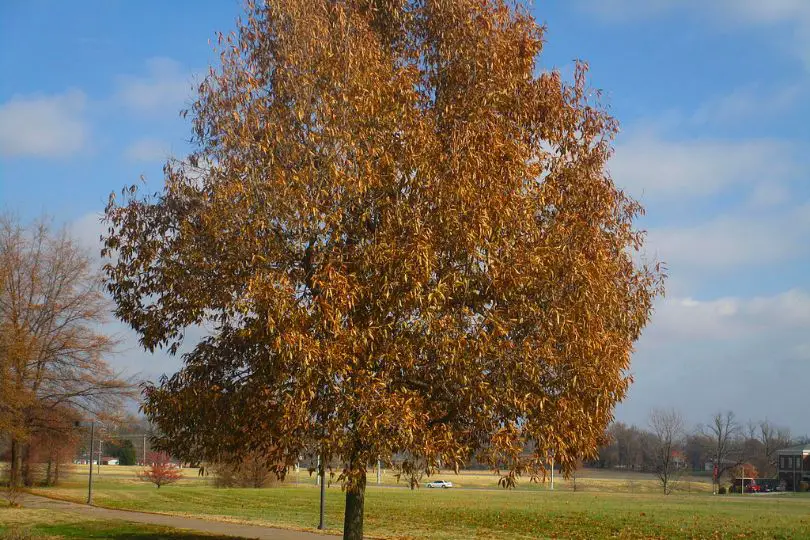
- Scientific Name: Quercus imbricaria
- Common Name(s): Shingle Oak
- Mature Height: 50-70 feet (15-21 meters)
- Native Region: North America
- Flowers: No Flowers.
- Fruit: Small acorns
- Uses: The wood of shingle oak is commonly used for making shingles, as the name suggests. It is also used for flooring, furniture, and cabinets. The acorns provide food for squirrels and other wildlife.
Shingle Oak, formally known as Quercus imbricaria, is a deciduous tree that can grow to be 50-70 feet (15-21 meters) tall when mature. It is native to North America and is common in Kansas landscapes. The tree’s rounded crown and strong trunk make it an appealing addition to any landscape.
The shingle oak’s leaves are simple and alternately arranged. They are oblong in shape and have a shiny green outer surface and a paler green below. The leaves turn a gorgeous shade of golden in the autumn, giving brilliant colors to the environment. The tree’s bark is pale gray and develops shallow fractures with age.
This oak tree is well-suited to the Kansas environment since it is soil-tolerant and can resist both wet and dry conditions. It grows best in full sun to medium shade and requires regular watering, especially during long dry seasons. Shingle oak is a wonderful choice for shade in the backyard or along a street.
While shingle oak does not have spectacular blossoms, it does have little acorns that attract wildlife, particularly squirrels. Acorns are a vital food source for many animals. Furthermore, the shingle oak’s tough and durable wood is widely used to make shingles, hence the name. It’s also used in the manufacture of flooring, furniture, and cabinets.
Shingle oak can be planted as a shade tree in yards, parks, and along streets in Kansas. It is a low-maintenance tree that requires little trimming and is resistant to most diseases and pests. During dry seasons, regular irrigation is critical, especially in the first few years after planting. Because of its robust wood and lovely foliage, the tree is popular for both landscaping and carpentry.
Similar Articles
- Common Pine Trees In Kansas
- Common Maple Trees In Kansas
- Common Ash Trees In Kansas
- Common Cedar Trees In Kansas
- Common Flowering Trees In Kansas
- Common Locust Trees In Kansas
- Common Cherry Trees In Kansas
- Common Cottonwood Trees In Kansas
- Common Hickory Trees In Kansas
- Common Elm Trees In Kansas
- Common Cypress Trees In Kansas
- Common Juniper Trees In Kansas
- Common Spruce Trees In Kansas
Native Oak Trees In Kansas – Sources
The Regional Gardening team makes sure that the information in our articles is accurate by only using sources that are known to be trustworthy. Some of these sources are peer-reviewed journals from government agencies, well-known universities, and scientific research organizations.
- Recommended Plants & Trees For Kansas, Kansas State University
- Native Tree Identification, Kansas Native Plant Society
- Discover Kansas Forests, Kansas Forest Service
- Preferred Trees for Southwest Kansas, Kansas State University


